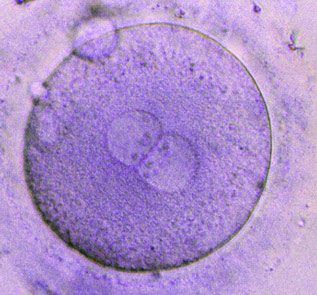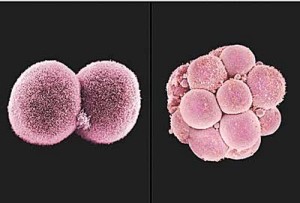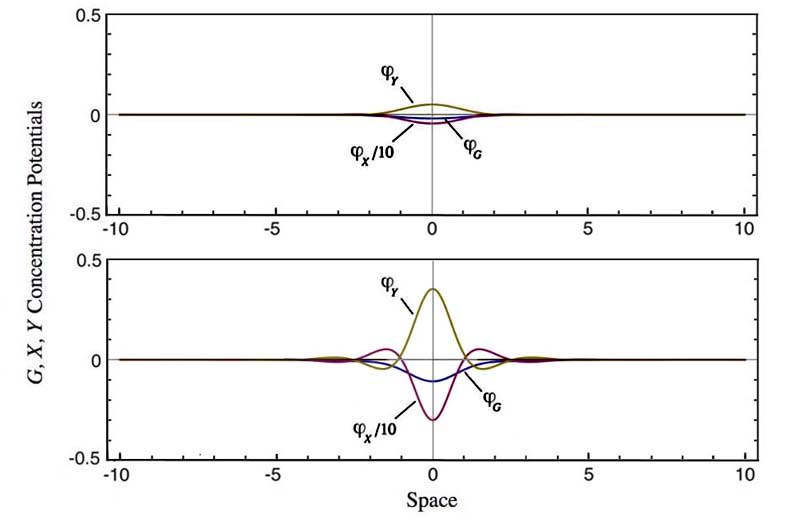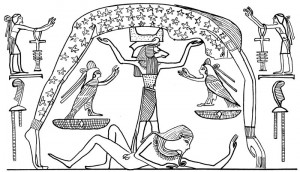Here is an attempt at a nontechnical presentation of the subquantum kinetics continuous creation cosmology. The universe is theorized to develop through a virgin birth materialization process that very much resembles biological parthenogenesis.
1) We begin with the initial electric potential pulse of sufficiently large size (i.e., a Y ether fluctuation of critical size) that arises spontaneously from the omnipresent fluctuating ether.
This stage of the matter creation process may be compared to the development of a fertilized egg.
2) If this pulse is of positive charge polarity, it will create a gravity potential well and this forms a fertile amplifying environment which causes the pulse to grow in size. This may be compared to the vascular placenta membrane that nourishes the egg within the uterus.
3) Over time, the electric potential pulse exponentially grows in magnitude as a result of the nourishing “supercritical conditions” that prevail in its environment. This may be compared to the egg dividing and subdividing to produce a growing embryo. The biological analogy is very approximate in this case since there is no compartmentalization or separation in the progressive growth of the seed fluctuation. It grows in size unitarily.
4) As the Y ether component of the electric potential pulse grows in magnitude (or concentration), its complementary X ether component progressively decreases in magnitude (or concentration); see left image below taken from a computer simulation of subquantum kinetics Model G (Pulver and LaViolette, 2013). The biological analogy is inadequate to illustrate this, except perhaps in the case of nerve impulse propagation. So we will illustrate it with this picture below to the right taken from the ancient Egyptian creation myth of Atum which depicts the primordial separation of Earth from Sky. The Earth god Geb (below) is seen being separated from his sister Sky goddess Nut (above) by their father, god of Air, Shu. All are described as being aspects of the sacred ether, called Nun. Here Nut depicts the upward arching Y ether component which progressively grows in magnitude and Geb depicts the downward arching X ether component which progressively decreases in magnitude. These also may be interpreted in terms of yin-yang metaphysics as the separation of yang (rising Y component) from yin (falling X component). As the concentrations of X and Y depart from one another, the gravity potential well that this electric potential pulse creates in its vicinity progressively deepens, ensuring an increasingly fertile environment for the growing energy pulse.
5) Eventually this growing energy pulse develops into a mature subatomic particle, a neutron. This is shown in the diagram below which depicts a cross sectional view of the Y, X, and G field potentials that make up the neutron. The neutron subsequently radioactively decays into a proton and electron pair to form ionized hydrogen.
This particle emergence and maturation may be compared to the birth of a child and its eventual growth into an adult.
6) The gravity well that the subatomic particle forms, creates a fertile environment that allows it to spawn progeny subatomic particles in its immediate vicinity through a repeat of the above parthenogenic process. This is depicted in the simulation of Model G shown below. This may be compared to the female adult spawning a child through the process of virgin birth (parthenogenesis). That is, an external male counterpart particle is not involved in this reproductive process. Rather the male fertilizing seed arises spontaneously within the body of the existing particle and grows to form a progeny particle. The progeny are always females in the sense that, when they mature into subatomic particles, they have the ability to spawn additional progeny subatomic particles.
7) A proton mother particle can then spawn a neutron progeny particle in its immediate vicinity which can form a nuclear bond leading to the formation of a deuteron (heavy hydrogen: proton-neutron nucleus). Alternatively, the materialized neutron might separate to form a separate daughter atomic nucleus. Parthenogenesis of a neutron within a deuteron nucleus would lead to the formation of a tritium nucleus (heavy hydrogen: proton-neutron-neutron nucleus) which would subsequently decay into a helium-3 nucleus (proton-neutron-proton nucleus). Parthenogenic creation of an additional neutron within the helium-3 nucleus would transmute it into a helium-4 nucleus. This nuclear transmutation sequence of hydrogen evolving into helium-4 may be compared to an initial single cell fertilized egg developing into a multicellular zygote. In the case where a progeny neutron separates from the mother nucleus to form a separate hydrogen particle creation center, this might be compared to a fertilized egg dividing to form identical twins and further dividing to form identical triplets, each evolving separately to form multicellular zygotes.
Higher mass nuclei, such as lithium nuclei and nuclei of more massive elements would take place through stellar nuclear fusion reactions.
The video entitled Parthenogenesis: A Sacred Journey, which is about the subquantum kinetics parthenogenesis process, is given as a gift to those donating $50 or more to the Starburst Foundation.







This is was an excellent comparison. Exactly like I had envisioned. To envision being able to do something other than speculate, is indeed the thing dreams are made of.
And then, it continues ad infinitum…I really liked the way you followed to explain it for us. I will donate the amount as soon as I can afford, maybe next month. Although I imagine the process, i also would like to see it. Thanks a lot Dr. LaViolette for this beautiful pieza de arte.
What creates the ‘omnipresent fluctuating ether’?
When you pass to the greater hyper dimensional realm of heaven, perhaps they will show you. From our limited knowledge we can only speculate.
Thank you Paul,
This is very fascinating!
Gratitude and Blessings,~Mary